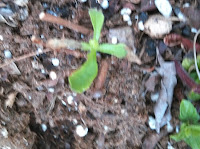At the end of February, I planted stevia* in our little boysenberry patch. Somehow I had learned that boysenberries like to grow near tall herbs that will bloom and attract insects to pollinate the berries. Thus our berries' companion plants currently include not only stevia but also Italian oregano, mint, purple-flowered sweet marjoram, and garlic (chives and bulbs). In spite of this carefully controlled environment, 2015 has been a terrible year for boysenberries. In fact, I think I have harvested about three (3) berries and simply popped them into my mouth in situ.
I expected stevia and boysenberries to be great companions on our table as well as in the garden. I envisioned big bowls of berries sweetened with chopped fresh stevia leaves. We often eat strawberries that way, and I've been looking forward to drying and grinding some stevia leaves for sweetening hot drinks. Just imagine a sugar bowl full of dark grey powder!
Sadly, it's been harder and harder to find the stevia plant in our berry bed, because tomatoes** have pretty well taken over the space. Several times, Steve has gone out to pick stevia and come back empty handed, but I knew that the herb had grown tall and was hiding its green leaves between the stems of an overgrown tomato plant. So I showed Steve that, though the stevia's main stem was dry and brown, there were some healthy green stems and leaves farther up. In fact, I was delighted to find that the plant was topped with tiny white blossoms, and, as a great fan of edible flowers, I was eager to sprinkle them onto the strawberries. Naturally, I assumed that the stevia blossoms were attracting insects that would pollinate any berry blossoms they might happen to find.
I've harvested and dried a lot of herbs over the years, but have never seen anything quite like the way the stevia's thick main stem had turned brown. Maybe it was time to read up on how to grow stevia. Sure enough, the Bonnie Plants stevia page had this advice: "Stevia bears small white flowers in the fall. At this point, the plant stretches out and offers fewer good leaves for harvest. Trim off the blooms to keep the plant producing leaves as long as possible." An accompanying photo made it quite clear what to do.
Working sadly, I cut the brown stevia stem about eight inches above the ground and then made a fistful of cuttings from the green leaves. I carefully placed the cuttings in water and commenced to wait for roots to appear.
Later, I went back to the berry patch intending to cut back the tomatoes. Here's what caught my eye:
Surprise! It's a baby stevia growing up from the root of the original plant. How sweet it is! And how glad am I that I've learned the permaculture technique of leaving the roots of dead and dying plants in the soil instead of pulling them up.
- - - -
* As high fructose corn syrup and a plethora of artificial sweeteners are losing popularity among health-conscious consumers, stevia's continuing trendiness is ensured by such phenomena as the 7th World Convention on Stevia, held in Berlin in June by the World Stevia Organization. Visit stevia.net for "a tale of incredible sweetness and intrigue."
** I'll save the explanation of this sad occurrence for another day, as I'm aiming for a happy ending right now.
Friday, October 16, 2015
Subscribe to:
Post Comments (Atom)


2 comments:
How DO you control the berries? We have thorny berry plants that spread like crazy and pop up EVERYwhere, throughout our entire space. Many ouches! I'd never plant berries again. ... I'm glad your Stevia experience is mostly positive and that you are growing it. Maybe we should add some in our gardening.
Your berries are obviously very happy. Mine are UNhappy and thus control themselves for the most part. As soon as I remove the tomato plants that have been threatening the berries' existence, I'm going to try a drastic pruning and tying.
Post a Comment